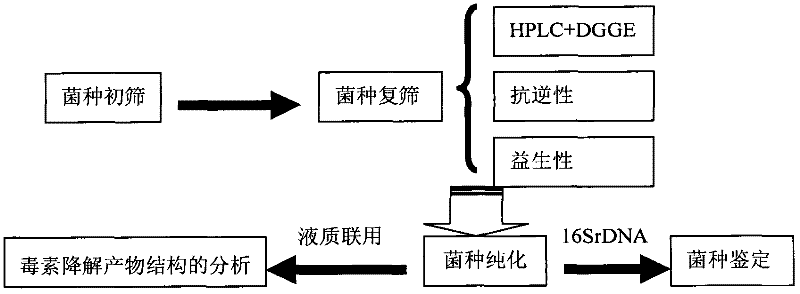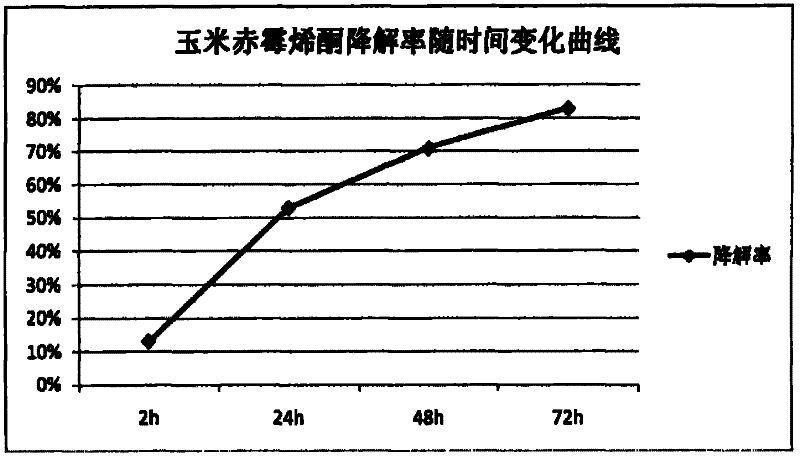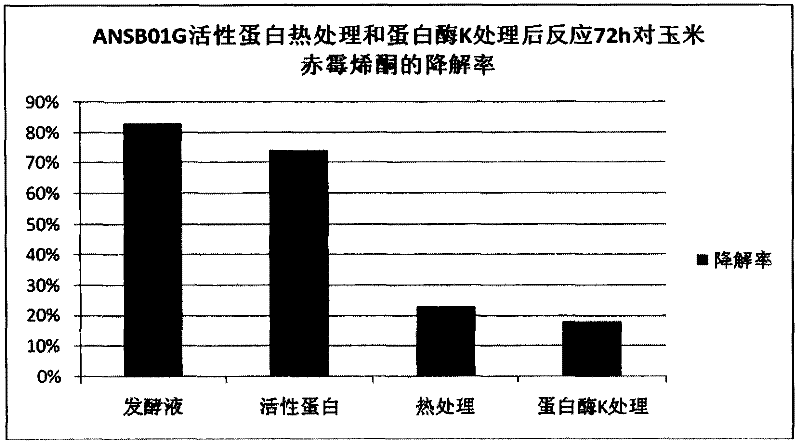Bacillus subtilis for simultaneously degrading zearalenone and cellulose and application thereof
A technology of Bacillus subtilis and zearalenone, which is applied in the field of Bacillus subtilis and its cultivation, can solve the problems of endangering the health of animals and humans, and low cellulose degradation, so as to benefit the health of animals, improve utilization rate, and operate simple effect
- Summary
- Abstract
- Description
- Claims
- Application Information
AI Technical Summary
Problems solved by technology
Method used
Image
Examples
Embodiment 1
[0044] The screening method of embodiment 1 bacterial strain
[0045] The strain screening process is as follows: figure 1 As shown, the specific steps are as follows:
[0046] 1) Screening of bacterial strains: In this study, strains were screened from animal intestinal contents, moldy feed, moldy food and natural environment.
[0047] Seed liquid preparation: Mix each intestinal content sample and the sample obtained from the environment with twice the volume of sterile water, place in a sterilized 18mm×180mm test tube, shake overnight; draw 0.1ml of the supernatant, respectively Mix it with 0.8ml of screening medium, and shake it in a 15°C incubator for 12 hours to obtain a seed solution.
[0048] Wherein, the formula of screening medium is: 0.25g NaH 2 PO 4 , 1.0g NH 4 NO 3 , 0.25g MgSO 4 .·7H 2 O, 0.001g FeSO 4 , 17g agar, 2.0g glucose, add distilled water to 1000ml, pH 7.0; steam sterilization at 121°C for 20min.
[0049] Preliminary screening of samples: Add 1...
Embodiment 2
[0061] Embodiment 2 The cultivation method of Bacillus subtilis of the present invention
[0062] Get Bacillus subtilis Bacillus subtilis ANSB01G CGMCC No.42971.5ml (viable bacteria concentration is 10 9 CFU / ml), inoculated in 80ml medium for shake flask fermentation culture, the fermentation temperature is 37°C, the pH value is 7.0, the rotation speed is 200r / min, and the fermentation time is 24h.
[0063] Among them, the shake flask fermentation medium is composed of the following components: tryptone 10g, yeast extract 2g, glucose 2g, beef extract 3g, sodium chloride 4g, disodium hydrogen phosphate 3g, magnesium sulfate heptahydrate 1.0g, distilled water 1000ml , pH value is 7.2.
[0064] After the fermentation, the fermentation broth was stored in a refrigerator at 4°C for later use.
Embodiment 3
[0065] Embodiment 3 The cultivation method of Bacillus subtilis of the present invention
[0066] Get Bacillus subtilis Bacillus subtilis ANSB01G CGMCC No.42970.5ml (viable bacteria concentration is 10 9 CFU / ml), inoculated in 50ml medium for shake flask fermentation culture, the fermentation temperature is 30°C, the pH value is 7.0, the rotation speed is 180r / min, and the fermentation time is 20h.
[0067] Among them, the shake flask fermentation medium is composed of the following components: tryptone 8g, yeast extract 1.5g, glucose 1.5g, beef extract 2g, sodium chloride 3g, disodium hydrogen phosphate 2.5g, magnesium sulfate heptahydrate 0.5g , Distilled water 800ml, pH value is 7.0.
[0068] After the fermentation, the fermentation broth was stored in a refrigerator at 4°C for later use.
PUM
| Property | Measurement | Unit |
|---|---|---|
| Diameter | aaaaa | aaaaa |
Abstract
Description
Claims
Application Information
 Login to View More
Login to View More - R&D
- Intellectual Property
- Life Sciences
- Materials
- Tech Scout
- Unparalleled Data Quality
- Higher Quality Content
- 60% Fewer Hallucinations
Browse by: Latest US Patents, China's latest patents, Technical Efficacy Thesaurus, Application Domain, Technology Topic, Popular Technical Reports.
© 2025 PatSnap. All rights reserved.Legal|Privacy policy|Modern Slavery Act Transparency Statement|Sitemap|About US| Contact US: help@patsnap.com



